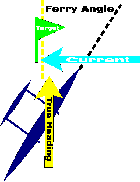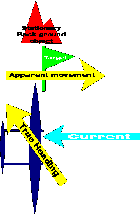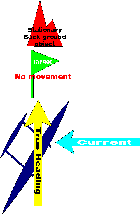|
Racing across Currents
Jude Turczynski
In one race or than another, we find ourselves paddling across tidal current or currents of various size, speed and direction. We might be crossing perpendicularly, diagonally with, or diagonally against these currents. In any of these cases, strategy can easily save us lost time and distance.
When we "ferry" across these currents towards our target (turning marker/finish line), we oddly must point our canoe "away" (up-current) from the target in order to travel the "Bee line" between two points (our target and where we are "now"). This pointing of your boat away from your target in order to arrive at your target is called "ferry angle" and is illustrated below.

The actual direction in which the canoe is traveling, no matter which direction it's pointed in, is called "True Heading."
Calculating the perfect ferry angle for any situation is a simple task...as long as you have a stationary object in view behind the target. Like, a mountain or an anchored boat, a piling, a bridge, or a coastal formation. Even non-stationary objects will work when there's nothing else, like a slow moving cloud!...Can't use birds, moving cargo ships or other canoes.
For example, you're headed for a buoy that is your turning marker ("Target") and let's say, "the current is coming from the right." You know that you must point your canoe up-current to the right in order to approach your target. Let's also say that there's a mountain in the distance behind your target. Align your target between you and the mountain...and try to keep it there. If your target "appears to move" to the right (towards the current), then you must increase the ferry angle until you've stabilized the position of the target between you and the mountain. See the figure below.

Above, the canoe must point farther to the right in order to slow or stop the "Apparent Movement" of his target towards the current (to the right).
Below, the ferry angle has been adjusted so that the target remains between the canoe and the "stationary background object."

Note: A stationary object "between you and your target" can serve just as well. But in this case, you'll have to think of the stationary object as the "temporary target" and your eventual target as the "temporary stationary object."
Another Note: Do not allow the ferry angle to be "greater than" 45 degrees from your target. If the current is so great that 45 degrees is not enough, you'll be better off ending up slightly down current from your target, paddling directly into the current to get to your target.
|